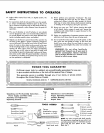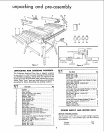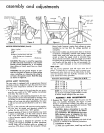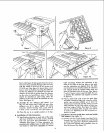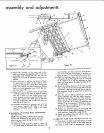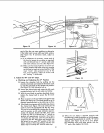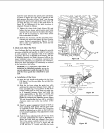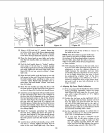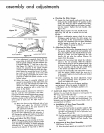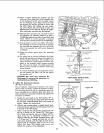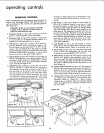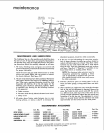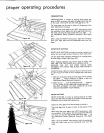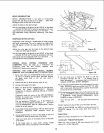
assembly and adjustments
Figure 26
DOWN
TO LOCK
Figure 27
FENCE PAWL
Figure 28
Figure 29
12
(5)
(6)
assembly (2) on the pinion shaft to achieve proper
alignment. Tighten the set screw (1) with a 1/8
inch hex-"L" wrench.
To adjust for correct gear mesh (depth of tooth
contact), loosen the set screw (3, figure 25) with
a 1/8 inch hex-"L" wrench and rotate the eccen-
tric (4) until proper mesh is obtained. Tighten the
set screw (3) after adjusting and check for proper
operation at various points along the rack.
Move the rip fence carefully across the central
portion of table, by rotating the gear knob, to
determine if the teeth engage the rack properly
at the center division. The fence should pass over
the center division of the rack smoothly. If any
binding or resistance is noticed it may be neces-
sary to loosen the guide bar attaching screws at
one end and at the middle, and shift the rack
enough to properly space the teeth at the center
division. Several trials may be necessary.
b. Checking for Parallelism of Rip Fence with
Table Groove.
(1)
With the lock handle not latched, slide the fence
on the saw table sothe front edge of the channel
is flush with the side of one of the two miter
grooves. (See figure 26.) Thiscan be checked by
usingyour fingers as shown to "feel" for correct
alignment. Shift the rear of the fence to the right
or left slightly, causing fence not to be squcre
with the front edge of the table nor pr_allel to
the miter groove.
(2) Push down on the lock handle carefully (do not
force) while watching the rear of the fence for
its correcting action.
CAUTION: Do not force the lack handle. If
the handle does not lock down readily, an
adjustment is necessary-and to force it
could cause damage to both the fence and
and guide bar.
(3) The lock handle should lock in the down position.
Do not force the handle, as it is not necessary for
the handle to be all the way down to lock the
fence. (See figure 27.) The rear of the fence
should move to correct itself, and do so parallel
(flush) with the miter groove in saw table through-
out its full length. Alignment may be checked with
the forefingers to determine if the fence is flush
with the side of miter groove, as shown in figures
26 and 27.
(4)
If the lock handle responded as described above,
and the fence aligned itself with the table groove
at both ends, the fence is properly adjusted and
no further attention is necessary. If not, perform
the following adjustment routine.
€. Adjusting the Rip Fence
(1) Remove the fence and turn it over. Then, with a
1/8 inch hex-"L '° wrench, loosen the pawl set
screw (located just behind the fence pawl) ap-
proximately two turns. (See figure 28.)



